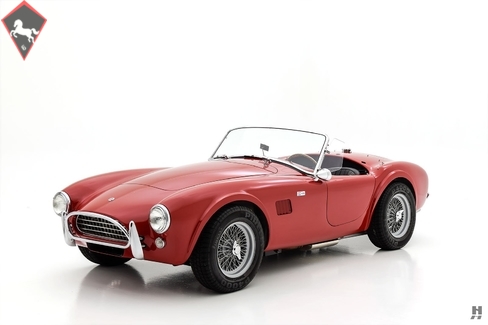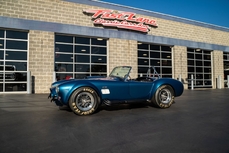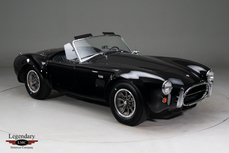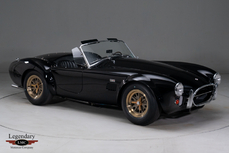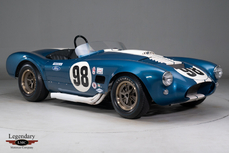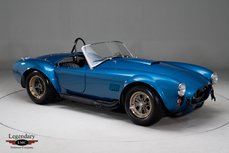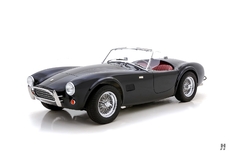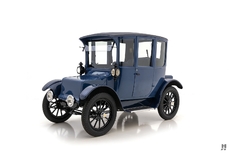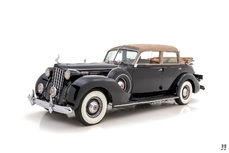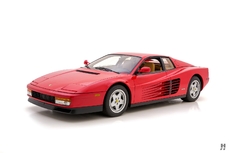Shelby Cobra 427 Roadster 1963
General description :
Automotive history has had its fair share of interesting characters, and Carroll Shelby will go down in history as one of the most colorful of them all. He had a successful, albeit short-lived career as a world-class racing driver, but his influence as a manufacturer and deal-maker is still felt today. He is among a small group of Americans to have found success in European sports car racing, and he is part of an elite group of American drivers to stand at the top step of the podium at Le Mans. While his motorsport aspirations as a driver were cut short due to a heart condition, his off-track exploits and creative business partnerships are what made him a household name.
With a Le Mans victory, numerous SCCA wins and several world land-speed records under his belt, Carroll Shelby was no doubt a keen driver with the experience and fine-tuned ability to identify a truly good car. Inspired by the likes of Sydney Allard before him, had the ambition to sell a European-style sports car with American power that he could aim directly at US enthusiasts eager to participate in sports car racing. Shelby briefly considered Healey, but Donald Healey had a perfectly good relationship with Austin. AC’s beautiful and fine-handling Ace Bristol deeply impressed Shelby, and he thought that if he could wedge a V8 in there, he might just create the ideal sports car for American buyers. The timing was perfect for AC as well, whose supply of proven Bristol engines was soon to dry up, and Ruddspeed-tuned Ford Zephyr six was proving to be quite fragile.
Shelby had the persona of a down-home Texas chicken farmer, but he was a shrewd businessman with a keen sense of engineering. He had done his homework, carefully measuring various engines and the AC chassis to ensure his plan was even feasible before approaching Detroit executives. After his idea was rebuffed by GM brass who didn’t want to infringe on the Corvette, Ford was all-ears to the concept. The new “Challenger” small block V8 had just been introduced and the new head of passenger cars Lee Iacocca was eager to erase Ford’s stodgy image. A deal was struck, Ford shipped a new 260 cubic inch thin-wall V8 to AC Cars of Thames Ditton, and the first prototype soon came to life. While it may be easy to say the rest is history – there was a considerable amount of engineering work on behalf of AC Cars to properly develop and strengthen the John Tojiero-designed chassis to handle what was, in essence, double the output of the original AC six. The Cobra legend was born when Dave MacDonald obliterated a field of Corvettes, Jaguars, and Porsches at Riverside Raceway to give the new car its first victory. Soon, American sports car enthusiasts were scrambling to get their hands on this pretty little Anglo-American hybrid. Like the man who created it, the Shelby Cobra became an icon.
In July 1964, Mark C. Tower purchased this car, CSX 2197 from Crater Lake Motors in Medford, Oregon. According to the Shelby Registry, the car was delivered in red over black leather and equipped with the Class A accessories package, which included chrome rocker covers, white sidewall tires, luggage rack, radio, and 5-quarts of anti-freeze which brought the invoice total to $5493.05. Mr. Tower owned the car briefly, and by 1966, CSX 2197 was held by Howard Nettleton of Tacoma, Washington. Shortly after that, it went to John Stevens Jensen of California where it was registered “VNN 794”. Mr. Stevens owned the car for several years until he was killed in a road accident in another Cobra. From 1981, it passed through several more known short-term owners. Along the way, it was noted to have just 9,700 miles on the odometer though it did show some signs of past front-end damage. In the late 1980s, CSX 2197 would find a long-term home with Bill Kemper, a highly respected Cobra expert and restorer. In the early 1990s, he embarked on a long-term restoration, working on the car as time permitted, taking the utmost care as it was a personal project.
According to Mr. Kemper, the car had been unused since suffering a relatively mild accident, and he believed the sub-10,000 miles on the odometer to be accurate. He reported that the Cobra was entirely stripped down, the chassis properly repaired and precisely reinforced and updated based on Kemper’s specifications by Baurle Auto Sport of Addison, Il. The body was completely restored, with great care given to preserving as much original alloy as possible. The front outer panels from the doors forward were replaced, but the doors, rear clip, footwells and engine bay panels are said to be comprised of original metal, painstakingly restored to a very high standard and returned to its original red color. Today it presents in stunning condition, having been used gently in the hands of its most recent owner.
Kemper, of course, had the engine balanced, blueprinted and completely rebuilt along with the gearbox and rear differential. It extremely well-presented with much of the original hardware restored and replated, and detailed with correct labels and markings. It retains its correct, early-type Harrison aluminum radiator as well as the generator which was unique to these early Cobras.
The interior is finished in black leather as originally equipped and features correct Smiths gauges with the wonderful Rotunda Tachometer to the left of the column (Shelby switched to Stewart-Warner gauges and Ford electrics approximately three cars later). The steering wheel and shift knob are also correct for the car’s original specification. This fabulous Cobra has seen only light use since its world-class restoration was completed, and the leather and upholstery remain in excellent condition. Included in the sale is a full top and side-curtain set, as well as the original early-type jack, firewall mounted grease gun, and a set of restored King Dick spanners.
Fully detailed and immaculately presented, this is an outstanding early Cobra with well-known provenance from new. It benefits from a meticulous, 3,000-plus hour restoration by a highly respected marque expert. Beautiful, highly correct and an absolute thrill to drive, CSX 2197 is an exquisite Cobra, ideally suited for rallies and tours.
https://hymanltd.com/vehicles/6241
1963 Shelby Cobra 427 Roadster is listed sold on ClassicDigest in St. Louis by Mark Hyman for $740000.
Car Facts
Car type : Car Make : Shelby Model : Cobra 427 Model Version : Roadster Engine size : 0.0 Model Year : 1963 Sub type : Convertible Location : Missouri
Sold
Seller Information
Sold
People who viewed this Shelby Cobra 427 also viewed similar Shelby listed at ClassicDigest
Other cars listed for sale by this dealer
About Shelby
Carroll Shelby, a legendary figure in the automotive world, had a remarkable journey from being a successful race car driver to becoming a renowned sports car manufacturer in the United States. His story is filled with achievements, innovations, and iconic cars that left an indelible mark on the industry.Early Years and Racing Career:
Carroll Shelby was born in 1923 in Texas. He initially pursued a career as a pilot during World War II but found his true passion in racing after the war. Shelby became a successful race car driver in the 1950s, competing in various events including Formula One, endurance racing, and the famous 24 Hours of Le Mans.
Shelby Cobras - Iconic Sports Cars:
Carroll Shelby's pivotal moment as a manufacturer came with the creation of the Shelby Cobra, an iconic American sports car. The Cobra was born from the fusion of a British AC Ace chassis and a Ford V8 engine, creating a lightweight, high-performance car that dominated tracks and streets alike. Key models include:
Shelby Cobra 260 (1962): The initial version with a 260 cubic inch (4.2L) V8 engine.
Shelby Cobra 289 (1963-1965): Later iterations with a 289 cubic inch (4.7L) V8 engine, including the competition-spec Cobras known for their racing prowess.
Shelby Cobra 427 (1965-1967): The most powerful iteration with a 427 cubic inch (7.0L) V8 engine, known for its raw power and performance.
Ford Partnership - Shelby Mustangs:
Shelby's partnership with Ford led to the creation of legendary Shelby Mustangs. The most notable model is:
Shelby GT350 (1965-1969): Based on the Ford Mustang, the GT350 was modified by Shelby American, featuring enhanced performance, handling, and distinct styling.
Other Notable Models and Achievements:
Beyond the Cobras and Mustangs, Shelby had several other significant contributions:
Shelby Daytona Coupe: Created to win against Ferrari in international GT racing, this car became the first American car to win the FIA GT World Championship in 1965.
Shelby Series 1: Introduced in the late 1990s, this was Shelby's modern take on a high-performance sports car.
Ford GT40 plays a pivotal role in Carroll Shelby's narrative, especially in his connection to Ford and his significant contribution to the car's success.
The Ford GT40 Development:
Ford's Challenge:
In the early 1960s, Henry Ford II sought to acquire Ferrari, but negotiations fell apart. This spurred Ford's determination to beat Ferrari at the prestigious 24 Hours of Le Mans endurance race, which Ferrari had dominated for several years.
Collaboration with Shelby:
Ford turned to Carroll Shelby, recognizing his racing expertise and track record. Shelby was tasked with leading the GT40 project and turning it into a competitive race car capable of challenging Ferrari's supremacy.
Development and Triumph:
Under Shelby's guidance, the Ford GT40 underwent rigorous development to address initial design flaws and performance issues. Several iterations were produced:
Early Attempts: The initial versions of the GT40 faced reliability and handling issues, leading to disappointing results at Le Mans in 1964.
GT40 Mark II: Shelby's team made crucial improvements. The Mark II, equipped with a powerful V8 engine, improved aerodynamics, and refined engineering, became highly competitive.
Le Mans Victory:
In 1966, the Ford GT40 Mark II achieved a historic victory at the 24 Hours of Le Mans, with Shelby-coached driver Ken Miles leading the race. This marked the first win for an American manufacturer at Le Mans, breaking Ferrari's dominance.
Continued Success:
The GT40 continued to dominate, winning Le Mans for the following three years (1966-1969), securing its place in racing history and solidifying Ford's reputation as a force in international motorsport.
Shelby's Contribution to the GT40 Success:
While Carroll Shelby wasn't directly involved in designing the GT40, his expertise in racing and his ability to assemble and lead a team of talented engineers, mechanics, and drivers were instrumental in refining the car's performance. His influence helped address technical issues, refine the car's handling, and strategize race tactics, contributing significantly to the GT40's success on the track.
Legacy and Impact:
The Ford GT40's victories at Le Mans under Shelby's guidance remain one of the most iconic achievements in motorsport history. The car's success solidified Shelby's reputation as an automotive visionary and further strengthened his partnership with Ford.
Carroll Shelby's involvement in the GT40 project showcased his ability to transform a struggling project into a championship-winning machine, adding another remarkable chapter to his illustrious career in the automotive world.
